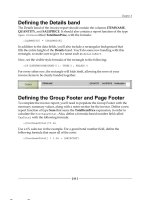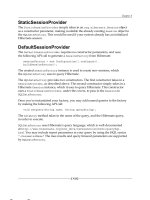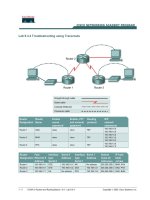Mastering phpmyadmin 3 4 for effective MySQL management
Bạn đang xem bản rút gọn của tài liệu. Xem và tải ngay bản đầy đủ của tài liệu tại đây (28.88 MB, 394 trang )
www.it-ebooks.info
Mastering phpMyAdmin 3.4 for
Effective MySQL Management
A complete guide to getting started with
phpMyAdmin 3.4 and mastering its features
Marc Delisle
BIRMINGHAM - MUMBAI
www.it-ebooks.info
Mastering phpMyAdmin 3.4 for Effective MySQL
Management
Copyright © 2012 Packt Publishing
All rights reserved. No part of this book may be reproduced, stored in a retrieval
system, or transmitted in any form or by any means, without the prior written
permission of the publisher, except in the case of brief quotations embedded in
critical articles or reviews.
Every effort has been made in the preparation of this book to ensure the accuracy
of the information presented. However, the information contained in this book is
sold without warranty, either express or implied. Neither the author, nor Packt
Publishing, and its dealers and distributors will be held liable for any damages
caused or alleged to be caused directly or indirectly by this book.
Packt Publishing has endeavored to provide trademark information about all of the
companies and products mentioned in this book by the appropriate use of capitals.
However, Packt Publishing cannot guarantee the accuracy of this information.
First published: February 2012
Production Reference: 1310112
Published by Packt Publishing Ltd.
Livery Place
35 Livery Street
Birmingham B3 2PB, UK.
ISBN 978-1-84951-778-2
www.packtpub.com
Cover Image by Michal Čihař ()
www.it-ebooks.info
Credits
Author
Project Coordinator
Marc Delisle
Jovita Pinto
Reviewers
Proofreader
Madhura Jayaratne
Mario Cecere
Rouslan Placella
Indexer
Lead Technical Editors
Tejal Daruwale
Kartikey Pandey
Meeta Rajani
Technical Editor
Kedar Bhat
Production Coordinator
Arvindkumar Gupta
Cover Work
Arvindkumar Gupta
www.it-ebooks.info
About the Author
Marc Delisle was awarded "MySQL Community Member of the year 2009"
because of his involvement with phpMyAdmin. He started to contribute to the
project in December 1998, when he made the multi-language version. He is involved
with phpMyAdmin as a developer, translator, and project administrator and enjoys
meeting phpMyAdmin users in person.
Marc is a system administrator at Cegep de Sherbrooke, Québec, Canada. He lives in
Sherbrooke with his wife and they enjoy spending time with their four children.
In addition to the "Mastering phpMyAdmin" successive editions, Marc has
written "Creating your MySQL Database: Practical Design Tips and Techniques" and
"phpMyAdmin Starter", also with Packt Publishing.
I am truly grateful to the Packt team whose sound comments were
greatly appreciated during the production. My thanks also go to the
reviewers of all editions; their sharp eyes helped in making this book
clearer and more complete.
Finally, I wish to thank all contributors to phpMyAdmin's source
code, translations, and documentation; their dedication to this
project continues to push me forward.
www.it-ebooks.info
About the Reviewers
Madhura Jayaratne is a Computer Science and Engineering graduate of
University of Moratuwa. Currently he works as a software engineer and is located in
Colombo, Sri Lanka.
He is a member of phpMyAdmin team and has contributed with GIS support for the
software, which will be a part of its future releases. He continues to contribute by
coding and translating the software.
Rouslan Placella, based in Cork, Ireland, is currently completing an Honors
degree in Software Development at the Cork Institute of Technology. Born in Saint
Petersbourg in 1985, his enthusiasm for programming and electronics was nurtured
from a very early age. He is passionate about high performance and secure software
and has been contributing to open source software with phpMyAdmin and Geeklog.
During the summer of 2011 he took part in the Google Summer of Code program,
where he developed an improved interface for MySQL routines, triggers, and events
for phpMyAdmin. He currently also teaches Math and programming to second and
third-level students.
www.it-ebooks.info
www.PacktPub.com
Support files, eBooks, discount offers, and more
You might want to visit www.PacktPub.com for support files and downloads related
to your book.
Did you know that Packt offers eBook versions of every book published, with PDF
and ePub files available? You can upgrade to the eBook version at www.PacktPub.
com and as a print book customer, you are entitled to a discount on the eBook copy.
Get in touch with us at for more details.
At www.PacktPub.com, you can also read a collection of free technical articles, sign
up for a range of free newsletters and receive exclusive discounts and offers on Packt
books and eBooks.
Do you need instant solutions to your IT questions? PacktLib is Packt's online
digital book library. Here, you can access, read and search across Packt's entire
library of books.
Why Subscribe?
•
Fully searchable across every book published by Packt
•
Copy and paste, print, and bookmark content
•
On demand and accessible via web browser
Free Access for Packt account holders
If you have an account with Packt at www.PacktPub.com, you can use this to access
PacktLib today and view nine entirely free books. Simply use your login credentials
for immediate access.
www.it-ebooks.info
www.it-ebooks.info
www.it-ebooks.info
This book is dedicated to Carole, André, Corinne, Annie, and Guillaume,
with all my love.
www.it-ebooks.info
www.it-ebooks.info
Table of Contents
Preface1
Chapter 1: Getting Started with phpMyAdmin
7
PHP and MySQL: The leading open source duo
What is phpMyAdmin?
Project documentation
Installing phpMyAdmin
Required information
System requirements
Downloading the files
Installing on different platforms
7
8
9
9
9
10
10
11
Configuring phpMyAdmin
The config.inc.php file
12
12
Installing on a remote server using a Windows client
Installing on a local Linux server
Installing on a local Windows server (Apache, IIS)
Avoiding false error messages about permissions on config.inc.php
Configuration principles
Web-based setup script
Manually creating config.inc.php
Tips for editing config.inc.php on a Windows client
Description of some configuration parameters
11
11
12
13
13
15
20
20
20
PmaAbsoluteUri21
Server-specific sections
21
Installing phpMyAdmin configuration storage
Goal of the configuration storage
Location of the configuration storage
Performing the installation
Installing for a single user
Installing for multiple users
www.it-ebooks.info
24
24
24
25
25
27
Table of Contents
Upgrading phpMyAdmin
Summary
Chapter 2: Configuring Authentication and Security
Logging in to MySQL through phpMyAdmin
Logging in to an account without a password
Authenticating a single user with config
Testing the MySQL connection
28
29
31
31
32
32
33
Authenticating multiple users
33
Configuring for multiple server support
38
Logging out
Securing phpMyAdmin
Protecting phpMyAdmin at directory level
Displaying error messages
Protecting with IP-based access control
40
40
40
41
41
Protecting in-transit data
Summary
43
44
Authenticating with HTTP
Authenticating with cookie values
Authenticating with signon mode
Defining servers in the configuration file
Authenticating through an arbitrary server
Defining rules
Order of interpretation for rules
Blocking root access
Chapter 3: Over Viewing the Interface
Over viewing panels and windows
Login panels
Navigation and main panels
33
34
36
38
39
42
42
43
45
45
45
46
Home page
46
Views46
Query window
46
Starting page
47
Customizing general settings
47
Configuring window title
47
Natural sort order for database and table names
48
Creating site-specific header and footer
48
Themes49
Configuring themes
Selecting themes
49
50
Selecting a language
50
Slider51
Restricting the list of databases
51
[ ii ]
www.it-ebooks.info
Table of Contents
Deactivating Ajax
Character sets and collations
Effective character sets and collations
Navigation panel
Configuring the logo
Database and table list
52
52
53
54
54
55
Choosing from the server list
Handling many databases or tables
59
60
Light mode
Full mode
Table abridged statistics
Table quick-access icon
Nested display of tables within a database
Counting the number of tables
Limits on the interface
Improving fetch speed
55
57
58
58
58
59
60
61
Main panel
Home page
Database view
Table view
Server view
Icons for home page and menu tabs
Opening a new phpMyAdmin window
User preferences
Accessing user preferences
Possible locations for saving preferences
61
62
63
64
65
65
66
66
67
67
Changing settings
Disallowing specific preferences
Showing developer settings
Query window
Summary
69
69
70
70
72
Saving in phpMyAdmin configuration storage
Saving in a file
Saving in the browser's local storage
Chapter 4: Creating and Browsing Tables
Creating a database
No privileges
First database creation is authorized
Creating our first table
Choosing the columns
Creating a table
Choosing keys
[ iii ]
www.it-ebooks.info
68
68
68
73
73
74
74
76
76
76
79
Table of Contents
Inserting data manually
Data entry panel tuning for CHAR and VARCHAR
Browse mode
SQL query links
Navigation bar
Query results operations
Displaying data as a chart
80
82
83
83
84
86
86
Sorting results
87
Color-marking rows or columns
Limiting the length of each column
89
90
Headwords
89
Display options
90
Browsing distinct values
Profiling queries
Creating an additional table
Summary
Chapter 5: Changing Data and Structure
Changing data
Entering edit mode
Moving to next field with the tab key
Moving with arrows
Handling NULL values
Applying a function to a value
Duplicating rows of data
91
92
92
94
95
95
95
97
97
97
98
100
Multi-row editing
Editing the next row
Inline row editing
Deleting data
101
102
102
103
Deleting a single row
Deleting multiple rows
Deleting all of the rows in a table
Deleting all rows in multiple tables
103
104
104
105
Deleting tables
Deleting databases
Changing table structure
Adding a column
105
106
107
107
Vertical mode
108
Editing column attribute
TEXT column type
BLOB (Binary Large Object) column type
108
109
110
ENUM and SET column types
113
Uploading binary content
[ iv ]
www.it-ebooks.info
111
Table of Contents
DATE, DATETIME, and TIMESTAMP column types
115
Bit column type
Managing indexes
117
118
Calendar pop up
TIMESTAMP option
Single-column indexes
Multi-column indexes and index editing
FULLTEXT indexes
Optimizing indexes with EXPLAIN
Detecting index problems
116
116
118
120
120
121
122
Summary
Chapter 6: Exporting Structure and Data (Backup)
Dumps, backups, and exports
Scope of the export
Exporting a database
The Table(s) sub-panel
The Output sub-panel
123
125
125
126
126
128
128
File name template
128
Choosing a character set
129
Kanji support
129
Compression129
Export formats
130
SQL130
CSV135
CSV for Microsoft Excel
136
PDF137
Microsoft Word 2000
137
LaTeX
138
XML139
Open document spreadsheet
140
Open document text
140
YAML141
CodeGen141
Texy! text
141
PHP array
142
MediaWiki table
142
JSON142
Exporting a table
Split-file exports
Exporting selectively
Exporting partial query results
Exporting and checkboxes
Exporting multiple databases
Saving the export file on the server
User-specific save directories
[v]
www.it-ebooks.info
143
143
143
144
144
145
146
147
Table of Contents
Memory limits
Summary
Chapter 7: Importing Structure and Data
Limits for the transfer
Time limits
Other limits
Handling big export files
Uploading into a temporary directory
Importing SQL files
Importing CSV files
Differences between SQL and CSV formats
Exporting a test file
148
148
149
150
150
151
151
152
152
154
154
154
CSV154
CSV using LOAD DATA
156
Requirements156
Using the LOAD DATA interface
157
Importing other formats
158
Open Document Spreadsheet
158
XML159
Reading files from a web server upload directory
160
Displaying an upload progress bar
161
Configuring APC
161
Summary
162
Chapter 8: Searching Data
Single-table searches
Entering the search page
Searching criteria by column—query by example
Searching for empty / non-empty values
Producing reports with Print view
Searching with wildcard characters
Case sensitivity and search
Combining criteria
Search options
Selecting the columns to be displayed
Ordering the results
Applying a WHERE clause
Avoiding repeated results
Performing a complete database search
Restricting search to a column
Stopping an errant query
Summary
[ vi ]
www.it-ebooks.info
163
163
163
164
165
166
166
168
168
168
168
169
169
170
171
172
173
173
Table of Contents
Chapter 9: Performing Table and Database Operations
175
Chapter 10: Benefiting from the Relational System
185
Maintaining a table
Changing table attributes
Table storage engine
Table comments
Table order
Table collation
Table options
Emptying or deleting a table
Renaming, moving, and copying tables
Appending data to a table
Performing other table operations
Multi-table operations
Repairing an "in use" table
Database operations
Renaming a database
Copying a database
Summary
Relational MySQL
InnoDB and PBXT
Defining relations with the relation view
Defining internal relations
Defining the relation
Defining the display column
Foreign key relations
Foreign keys without phpMyAdmin configuration storage
176
177
177
177
178
179
180
180
181
182
182
182
183
183
184
184
184
185
186
186
187
188
188
189
192
Defining relations with the Designer
Over viewing the interface
Defining relations
192
193
195
Defining the display column
Exporting for PDF schema
Benefiting from the defined relations
Foreign key information
The drop-down list of foreign keys
The browseable foreign-table window
Referential integrity checks
Automatic updates of metadata
197
197
197
197
199
200
200
201
Defining foreign key relations
[ vii ]
www.it-ebooks.info
196
Table of Contents
Column commenting
Automatically migrating column comments
Summary
Chapter 11: Entering SQL Statements
The SQL query box
The Database view
The Table view
The Columns selector
Clicking into the query box
201
202
203
205
205
206
207
208
208
The Query window
Query window options
Session-based SQL history
Database-based SQL history (permanent)
Editing queries
Multi-statement queries
Pretty printing (syntax highlighting)
The SQL Validator
System requirements
Making the Validator available
Validator results
209
210
210
210
211
212
213
213
214
214
215
Summary
216
Standard-conforming queries
Non standard-conforming queries
Chapter 12: Generating Multi-table Queries
Choosing tables
Exploring column criteria
Column selector: Single column or all columns
Sorting columns
Showing a column
Updating the query
Adding conditions to the criteria box
Adjusting the number of criteria rows
Adjusting the number of criteria columns
Generating automatic joins (internal relations)
Executing the query
The visual builder
Summary
Chapter 13: Synchronizing Data and Supporting Replication
Synchronizing data and structure
Goals of synchronization
Moving between the development and production servers
[ viii ]
www.it-ebooks.info
215
216
217
218
219
219
220
220
220
221
223
224
224
225
226
228
229
229
230
230
Table of Contents
Collaboration between database designers
Preparing for replication
Over viewing the synchronization process
Preparing for the synchronization exercise
Choosing source and target servers and databases
Analyzing comparison results
Performing a complete synchronization
Performing a selective synchronization
Supporting MySQL replication
The Replication menu
Configuring replication
Master server configuration
Slave server configuration
Setting up a test environment
Controlling a slave server
Obtaining replication information
230
230
231
231
232
234
236
236
237
238
238
239
242
243
244
245
Gathering replication status
Replicated databases
Replicated tables
245
245
246
Summary
247
Chapter 14: Using Query Bookmarks
249
Chapter 15: Documenting the System
261
Comparing bookmark and query history features
Creating bookmarks
Creating a bookmark after a successful query
Storing a bookmark before sending a query
Making bookmarks public
The default initial query for a table
Multi-query bookmarks
Recalling bookmarks from the bookmarks list
Executing bookmarks
Manipulating bookmarks
Passing a parameter to a bookmark
Creating a parameterized bookmark
Passing the parameter value
Summary
Producing structure reports
Creating a printable report
The database print view
The selective database print view
The table print view
Preparing a complete report with the data dictionary
[ ix ]
www.it-ebooks.info
250
250
250
252
253
254
255
256
256
257
257
257
258
259
261
261
262
262
263
264
Table of Contents
Generating relational schemas
Adding a third table to our model
264
265
Laying out a schema with the Designer feature
Summary
272
273
Producing schema pages
Page planning
Creating a new page
Editing a page
Exporting a page for display
Changing the font in PDF schema
Chapter 16: Transforming Data using MIME
Browsing data without transformations
Switching display options
Enabling transformations
Configuring settings for MIME columns
Selecting the MIME type
Browser transformations
Assigning values to transformation options
266
266
266
267
269
271
275
275
276
276
277
278
278
279
Requirements for image generation
279
Examples of transformations
Clickable thumbnail (JPEG or PNG)
Adding links to an image
Date formatting
Links from text
281
281
282
283
283
Configuring GD2 library availability verification
Asserting support of JPEG and PNG libraries
Evaluating the impact of memory limits
text/plain: link
text/plain: imagelink
Preserving the original formatting
Displaying parts of a text
Displaying a download link
Hexadecimal representation
SQL pretty printing
IP address
Transforming data via external applications
External application example: In-cell sort
Summary
Chapter 17: Supporting Features Added in MySQL 5
Supporting views
Creating a view from results
Main panel and views
Controlling row counting for improved performance
[x]
www.it-ebooks.info
280
280
281
284
284
286
286
286
287
288
288
288
289
290
291
291
292
294
295
Table of Contents
Supporting routines—stored procedures and functions
Creating a stored procedure
Changing the delimiter
Entering the procedure
295
296
296
297
Testing the procedure
297
Manipulating procedures and functions
298
Manually creating a function
299
Testing the function
300
Exporting stored procedures and functions
300
Executing code with triggers
301
Manually creating a trigger
302
Testing the trigger
303
Using information_schema
303
Partitioning
304
Creating a table with partitions
304
Maintaining partitions
305
Exporting a partition definition
305
Exploring the event scheduler
306
Activating the scheduler
306
Granting EVENT permission
306
Creating an event
306
Manipulating events
307
Exporting307
Summary
307
Chapter 18: Tracking Changes
309
Understanding the goals of the tracking system
309
Tracking in other software applications
309
Tracking in phpMyAdmin
310
Prerequisites
310
Configuring a basic tracking mechanism
311
Principles
311
Versioning311
Taking a snapshot of the current structure
312
Understanding archiving issues
312
Initiating tracking for one table
313
Choosing the statements to be tracked
315
Testing the tracking mechanism
315
Tracking report
316
Determining tracking status
317
Deactivating and activating tracking
320
[ xi ]
www.it-ebooks.info
Table of Contents
Structure snapshot
Exporting a version
Creating a new version
Quickly accessing tracking information
Deleting tracking information
Summary
Chapter 19: Administrating the MySQL Server
Managing users and their privileges
The user overview
Exporting privileges
Privileges reload
320
321
322
323
323
324
325
325
326
327
328
Adding a user
328
Editing a user profile
331
Entering the username
Assigning a host value
Setting passwords
Understanding rights for database creation
Assigning global privileges
Limiting the resources used
Editing global privileges
Assigning database-specific privileges
Changing the password
Changing login information or copying a user
Removing a user
Database information
Enabling statistics
Sorting the statistics
Checking the database privileges
Dropping selected databases
Server information
Verifying server status
Server variables
Server processes
Storage engines
Available character sets and collations
Examining binary logs
Summary
Appendix: Troubleshooting and Support
Troubleshooting
System requirements
Verifying the base configuration
Solving common errors
[ xii ]
www.it-ebooks.info
329
329
330
330
330
331
331
332
334
334
336
336
337
337
338
338
339
339
341
341
342
343
343
344
345
345
345
346
346
Table of Contents
Seeking support
346
FAQs347
Help forums
347
Creating a SourceForge account
Choosing the thread title
Reading the answers
347
347
347
Using the support tracker
Using the bug tracker
348
348
Environment description
Bug description
348
348
Contributing to the project
349
The code base
349
Translation updates
349
Patches349
Index
351
[ xiii ]
www.it-ebooks.info
www.it-ebooks.info









